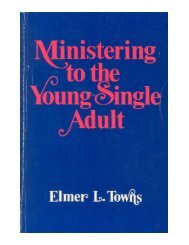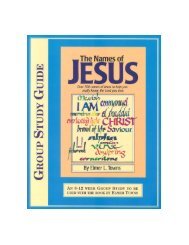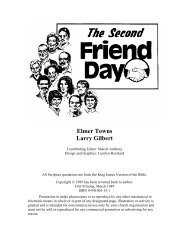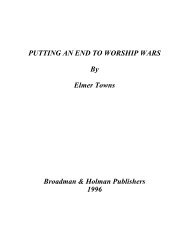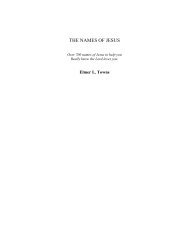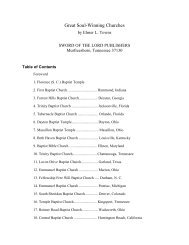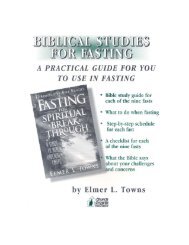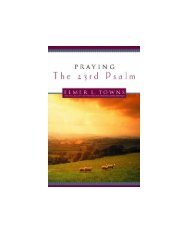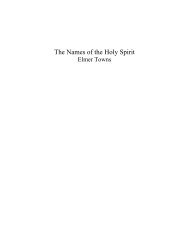A Journey Through The Old Testament - Elmer Towns
A Journey Through The Old Testament - Elmer Towns
A Journey Through The Old Testament - Elmer Towns
Create successful ePaper yourself
Turn your PDF publications into a flip-book with our unique Google optimized e-Paper software.
Though most of the book contains an apparently random selection of short, pithy sayings<br />
or principles, the first part of the book, entitled “<strong>The</strong> Words of the Wise” (1:6b-9:18), appears to<br />
have a more exact order and sequence of thought in its declarations. Some conservative Bible<br />
teachers explain this difference claiming this part of the book is the instructions prepared by<br />
rabbis (teaching priests) appointed by David to teach the law of God to his son and heir to the<br />
throne. Those who hold this view point to the often-repeated phrase “my son” in this section of<br />
the book (which is typical of rabbinical teaching) and to the numerous apparent parallels between<br />
the teaching of this part of the book and the Book of Deuteronomy.<br />
<strong>The</strong> Book of Ecclesiastes<br />
<strong>The</strong> Book of Ecclesiastes identifies its author by the title “the Preacher.” Though<br />
Solomon is not specifically named in the book, the Preacher is identified as both the Son of<br />
David and king in Jerusalem (Ecc. 1:1). <strong>The</strong> only person the Preacher could be on this basis is<br />
Solomon. In this book, perhaps written toward the end of his life, Solomon recounts the vanity of<br />
his various life experiences, concluding that the futility and emptiness of life demonstrates rather<br />
than negates the need for sound knowledge and wisdom. <strong>The</strong> author’s purpose in writing the<br />
book is stated in the last chapter: “And moreover, because the Preacher was wise, he still taught<br />
the people knowledge; yes, he pondered and sought out and set in order many proverbs” (12:9).<br />
Over the years since its writing, many interpreters of the Scripture have encountered<br />
problems in this book of the Bible. At times it seems that the author is teaching something<br />
contrary to the clear teaching of another part of Scripture. Indeed, various historic and<br />
contemporary cults have appealed to obscure passages in the Book of Ecclesiastes to prove their<br />
variant doctrinal themes are taught in the Bible. But the problems associated with Ecclesiastes<br />
are not problems with the book but rather reflect the interpreters’ failure to recognize the two<br />
distinct kinds of knowledge taught in this book. As the author himself declares, “the words of the<br />
wise are like goads, and the words of the scholars [collected sayings] are like well-driven nails,<br />
given by one Shepherd” (v. 11, italics added). In interpreting this book, one must distinguish<br />
between the ten “goad” passages (1:2-11, 12-18; 2:1-11, 12-23; 4:1-3, 4-12, 13-16; 5:1-7, 8-17;<br />
6:1-12) and the seven “nail” passages (3:1-11, 12-13, 14-21; 7:1-29; 8:1-9:18; 10:1-20; 11:1-<br />
12:7). As noted on the chart above, each of these two kinds of knowledge has a different source,<br />
effect, purpose, and life result.



